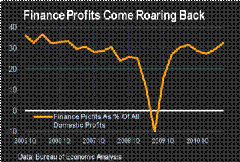This is exactly how crony capitalism looks like.
Following massive support from the US government, US financial firms posts huge profits.
From the Wall Street Journal, (bold highlights mine)
During the darkest days of the financial crisis, when Lehman Brothers and Washington Mutual went belly up and the U.S. government had to bail out other institutions, the finance sector reported an annualized loss of $65.2 billion in the fourth quarter of 2008. It was the only quarterly loss recorded in the government data.
Since then, the sector has come roaring back. The GDP report shows finance profits jumped to $426.5 billion. While profits haven’t returned to their high levels of 2006, the gain in finance profits last quarter more than offset a drop in profits posted by nonfinancial domestic industries.
After rising like the Phoenix, the financial industry now accounts for about 30% of all operating profits. That’s an amazing share given that the sector accounts for less than 10% of the value added in the economy.
Wall Street and banking critics have pointed out the finance industry enjoys government supports not given to other companies. That includes the low cost of funds from the Federal Reserve. As a result, critics say, the U.S. economy is overly skewed toward finance.
Aside from the bailouts and behest loans, the Federal Reserve’s QE programs have had a big influence on this swelling of corporate profits.
Writes Peter Schiff, (bold highlights mine)
But another very large chunk of Treasuries go to "primary dealers," the very large financial institutions that are designated middle men for Treasury bonds. In a late February auction, these dealers took down 46% of the entire $29 billion issue of seven year bonds. While this is hardly remarkable, it is shocking what happened next.
According to analysis that appeared in Zero Hedge, nearly 53% of those bonds were then sold to the Federal Reserve on March 8, under the rubric of the Fed's quantitative easing plan. While it's certainly hard to determine the profits that were made on this two week trade, it's virtually impossible to imagine that the private banks lost money. What's more, knowing that the Fed was sure to make a bid, the profits were made essentially risk free. It's good to be on the government's short list.
So what we essentially have is a redistribution of resources from the real economy to the financial sector.
This is rent-seeking.
The essence of which is, as explained by Alfred Nobel Prize winner Professor James M. Buchanan,
“it extends the idea of the profit motive from the economic sphere to the sphere of collective action. It presupposes that if there is value to be gained through politics, persons will invest resources in efforts to capture this value. It also demonstrates how this investment is wasteful in an aggregate-value sense.
Such is the essence of government interventions or the political distribution of resources via state capitalism. Winners are the politically endowed (concentrated) while losses are distributed throughout the system.

No comments:
Post a Comment